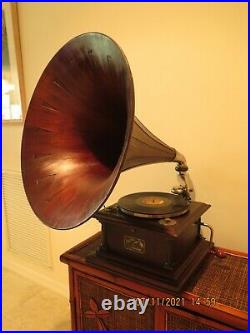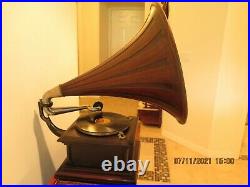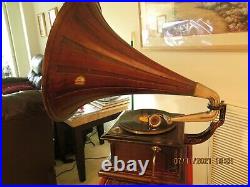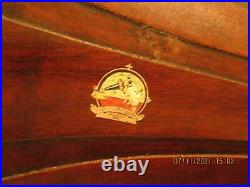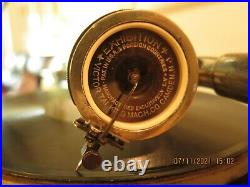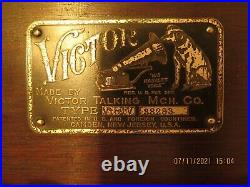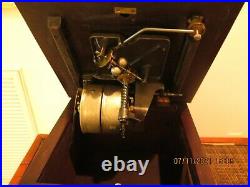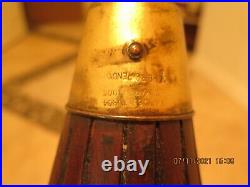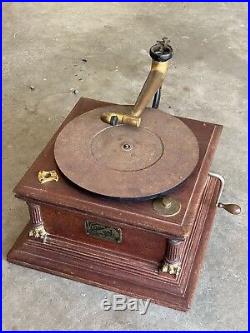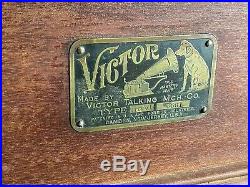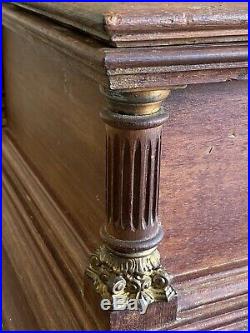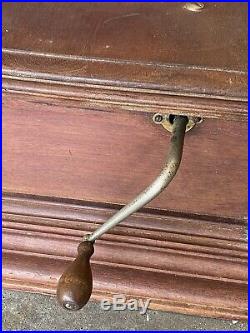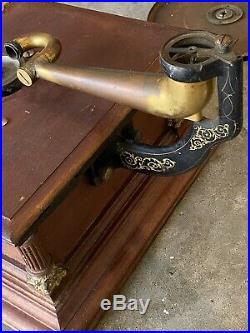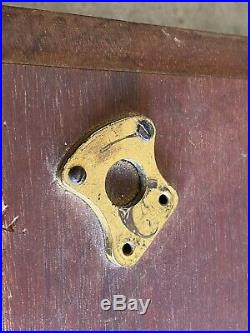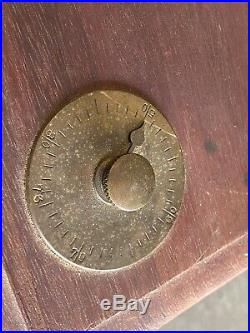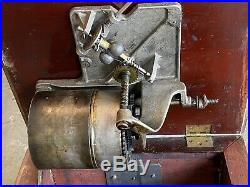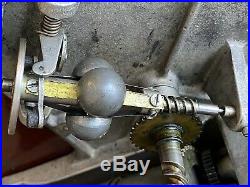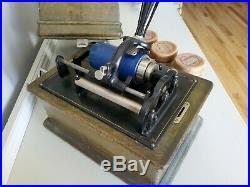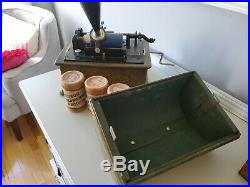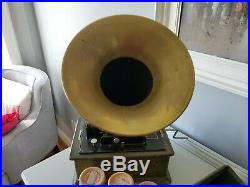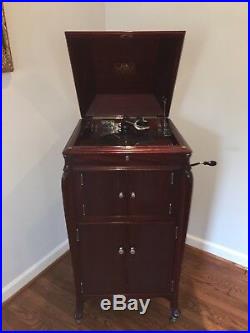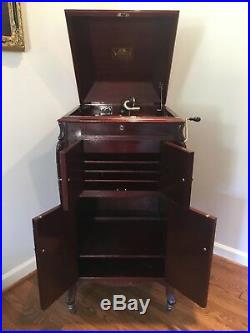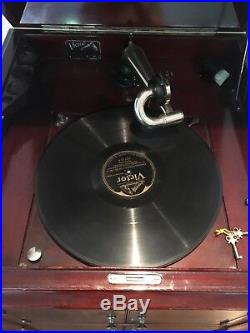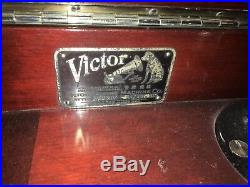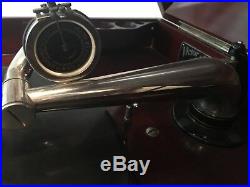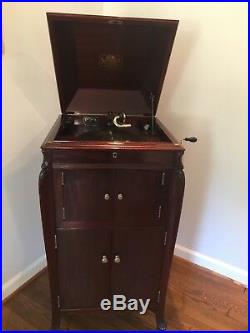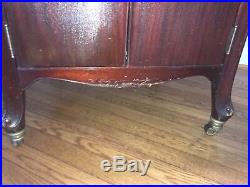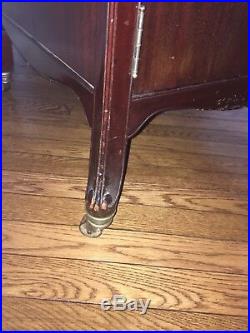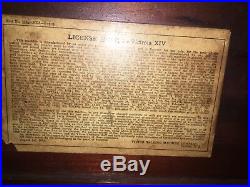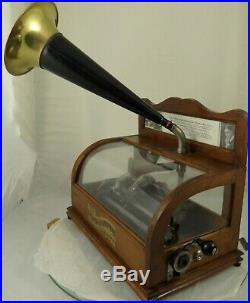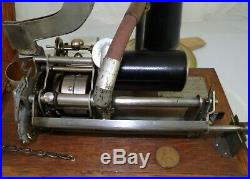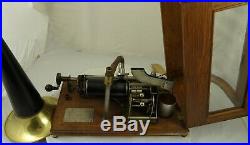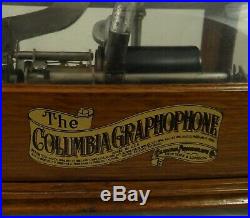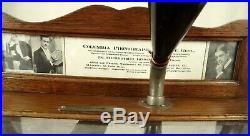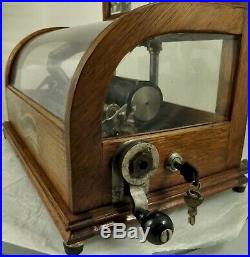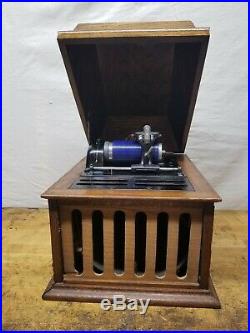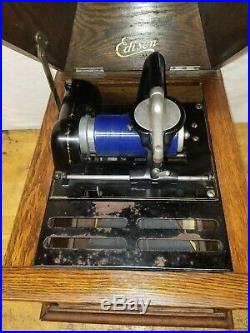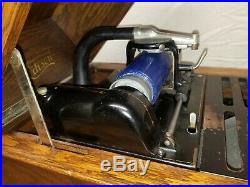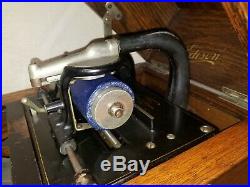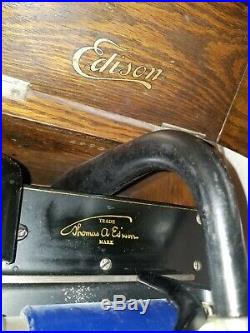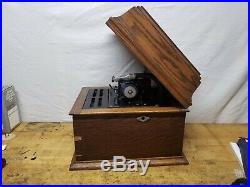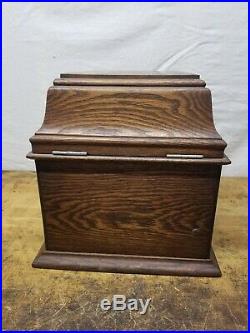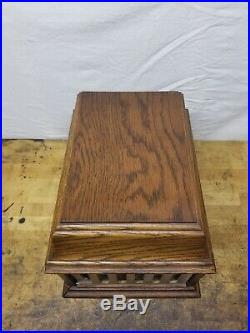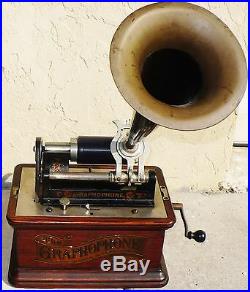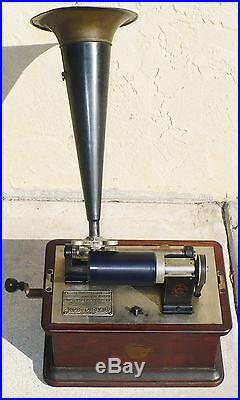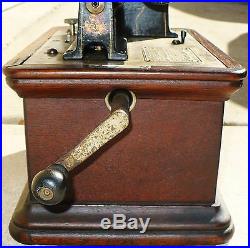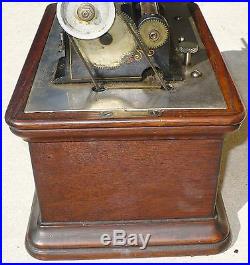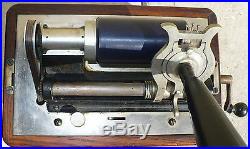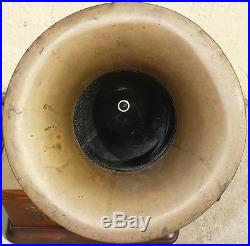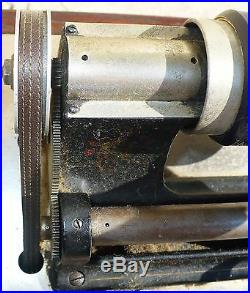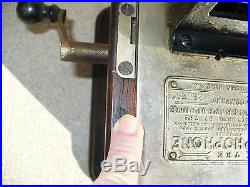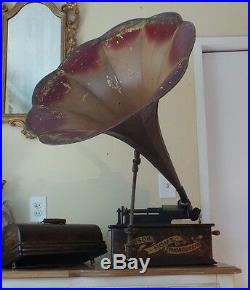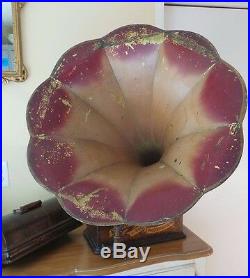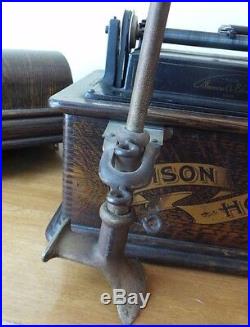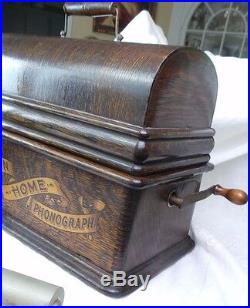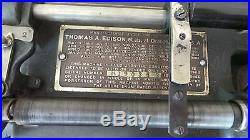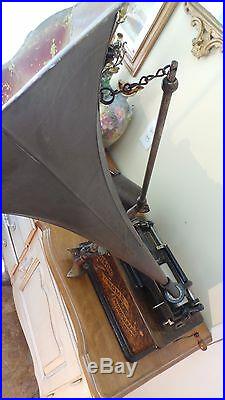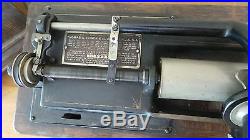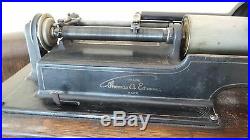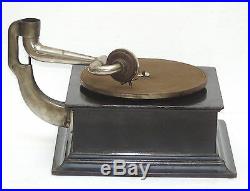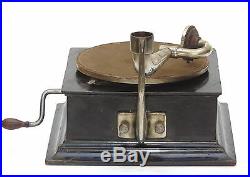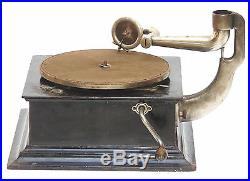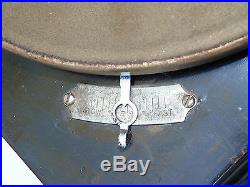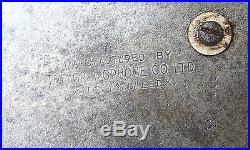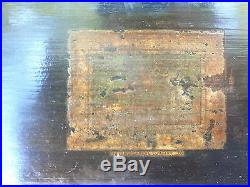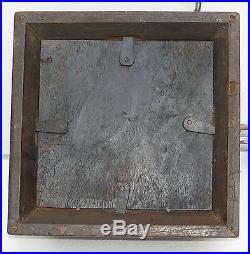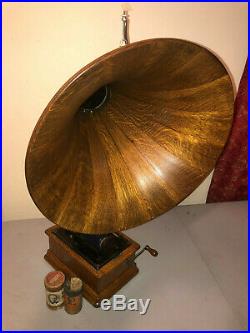
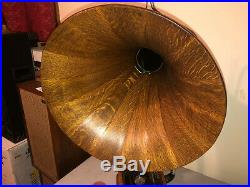
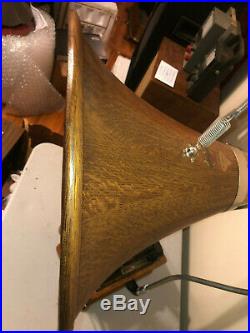
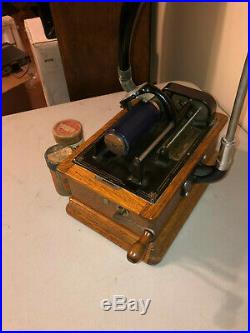
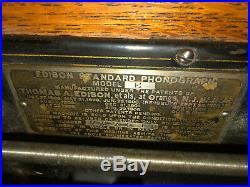

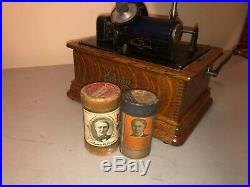
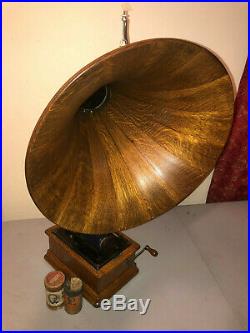
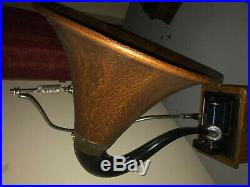
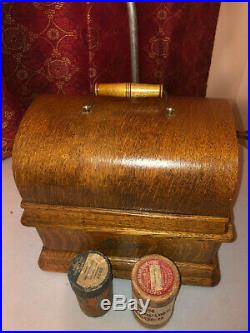
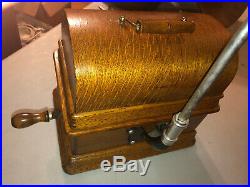
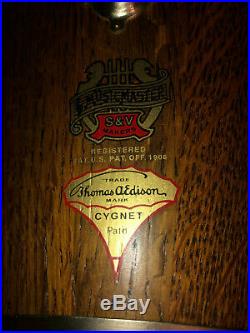

ANTIQUE 1908 THOMAS EDISON PHONOGRAPH WITH RARE WOODEN CYGNET EDISON HORN. THE PHONOGRAPH BOX MEASURES 13″L X 9 1/2″ D X 13 H WITH WOODEN LID. TOTAL HEIGHT WITH HORN IS 37″ AND WOODEN HORN MEASURES 20″D. THIS EDISON PHONOGRAPH COMES FROM THE HISTORIC BOSTON EDISON NEIGHBORHOOD AREA WHERE THOMAS EDISON ONCE LIVED AND WAS GOOD BUSINESS ASSOCIATE FRIENDS WITH HENRY FORD. PLEASE SEE ATTACHED DESCRIPTION OF THOMAS EDISON BELOW. History of the Cylinder Phonograph. Phonograph Catalog/Advertisement: I want a phonograph in every home… The phonograph was developed as a result of Thomas Edison’s work on two other inventions, the telegraph and the telephone. In 1877, Edison was working on a machine that would transcribe telegraphic messages through indentations on paper tape, which could later be sent over the telegraph repeatedly. This development led Edison to speculate that a telephone message could also be recorded in a similar fashion. He experimented with a diaphragm which had an embossing point and was held against rapidly-moving paraffin paper. The speaking vibrations made indentations in the paper. Edison later changed the paper to a metal cylinder with tin foil wrapped around it. The machine had two diaphragm-and-needle units, one for recording, and one for playback. When one would speak into a mouthpiece, the sound vibrations would be indented onto the cylinder by the recording needle in a vertical (or hill and dale) groove pattern. Edison gave a sketch of the machine to his mechanic, John Kruesi, to build, which Kruesi supposedly did within 30 hours. Edison immediately tested the machine by speaking the nursery rhyme into the mouthpiece, Mary had a little lamb. To his amazement, the machine played his words back to him. Although it was later stated that the date for this event was on August 12, 1877, some historians believe that it probably happened several months later, since Edison did not file for a patent until December 24, 1877. Also, the diary of one of Edison’s aides, Charles Batchelor, seems to confirm that the phonograph was not constructed until December 4, and finished two days later. The patent on the phonograph was issued on February 19, 1878. The invention was highly original. The only other recorded evidence of such an invention was in a paper by French scientist Charles Cros, written on April 18, 1877. There were some differences, however, between the two men’s ideas, and Cros’s work remained only a theory, since he did not produce a working model of it. Original Edison Tin Foil Phonograph. Photo courtesy of U. Department of the Interior, National Park Service, Edison National Historic Site. Edison took his new invention to the offices of. In New York City and showed it to staff there. As the December 22, 1877, issue reported, Mr. Interest was great, and the invention was reported in several New York newspapers, and later in other American newspapers and magazines. The Edison Speaking Phonograph Company was established on January 24, 1878, to exploit the new machine by exhibiting it. As a novelty, the machine was an instant success, but was difficult to operate except by experts, and the tin foil would last for only a few playings. Ever practical and visionary, Edison offered the following possible future uses for the phonograph in. Letter writing and all kinds of dictation without the aid of a stenographer. Phonographic books, which will speak to blind people without effort on their part. The teaching of elocution. The “Family Record”–a registry of sayings, reminiscences, etc. By members of a family in their own voices, and of the last words of dying persons. Clocks that should announce in articulate speech the time for going home, going to meals, etc. The preservation of languages by exact reproduction of the manner of pronouncing. Educational purposes; such as preserving the explanantions made by a teacher, so that the pupil can refer to them at any moment, and spelling or other lessons placed upon the phonograph for convenience in committing to memory. Connection with the telephone, so as to make that instrument an auxiliary in the transmission of permanent and invaluable records, instead of being the recipient of momentary and fleeting communication. Eventually, the novelty of the invention wore off for the public, and Edison did no further work on the phonograph for a while, concentrating instead on inventing the incadescent light bulb. In the void left by Edison, others moved forward to improve the phonograph. Bell used his winnings to set up a laboratory to further electrical and acoustical research, working with his cousin Chichester A. Bell, a chemical engineer, and Charles Sumner Tainter, a scientist and instrument maker. They made some improvements on Edison’s invention, chiefly by using wax in the place of tin foil and a floating stylus instead of a rigid needle which would incise, rather than indent, the cylinder. A patent was awarded to C. Bell and Tainter on May 4, 1886. The machine was exhibited to the public as the graphophone. Bell and Tainter had representatives approach Edison to discuss a possible collaboration on the machine, but Edison refused and determined to improve the phonograph himself. At this point, he had succeeded in making the incandescent lamp and could now resume his work on the phonograph. His initial work, though, closely followed the improvements made by Bell and Tainter, especially in its use of wax cylinders, and was called the New Phonograph. The Edison Phonograph Company was formed on October 8, 1887, to market Edison’s machine. He introduced the Improved Phonograph by May of 1888, shortly followed by the Perfected Phonograph. The first wax cylinders Edison used were white and made of ceresin, beeswax, and stearic wax. Lippincott assumed control of the phonograph companies by becoming sole licensee of the American Graphophone Company and by purchasing the Edison Phonograph Company from Edison. In an arrangement which eventually included most other phonograph makers as well, he formed the North American Phonograph Company on July 14, 1888. Lippincott saw the potential use of the phonograph only in the business field and leased the phonographs as office dictating machines to various member companies which each had its own sales territory. Unfortunately, this business did not prove to be very profitable, receiving significant opposition from stenographers. Meanwhile, the Edison Factory produced talking dolls in 1890 for the Edison Phonograph Toy Manufacturing Co. The dolls contained tiny wax cylinders. Edison’s relationship with the company ended in March of 1891, and the dolls are very rare today. The Edison Phonograph Works also produced musical cylinders for coin-slot phonographs which some of the subsidiary companies had started to use. These proto-“jukeboxes” were a development which pointed to the future of phonographs as entertainment machines. In the fall of 1890, Lippincott fell ill and lost control of the North American Phonograph Co. To Edison, who was its principal creditor. Edison changed the policy of rentals to outright sales of the machines, but changed little else. Edison increased the entertainment offerings on his cylinders, which by 1892 were made of a wax known among collectors today as brown wax. Although called by this name, the cylinders could range in color from off-white to light tan to dark brown. An announcement at the beginning of the cylinder would typically indicate the title, artist, and company. Advertisement for the Edison New Standard Phongraph, in. It took two years for the bankruptcy affairs to be settled before Edison could move ahead with marketing his invention. The Edison Spring Motor Phonograph appeared in 1895, even though technically Edison was not allowed to sell phonographs at this time because of the bankruptcy agreement. In January 1896, he started the National Phonograph Company which would manufacture phonographs for home entertainment use. Within three years, branches of the company were located in Europe. Under the aegis of the company, he announced the Spring Motor Phonograph in 1896, followed by the Edison Home Phonograph, and he began the commercial issue of cylinders under the new company’s label. A year later, the Edison Standard Phonograph was manufactured, and then exhibited in the press in 1898. Standard-sized cylinders, which tended to be 4.25″ long and 2.1875″ in diameter, were 50 cents each and typically played at 120 r. A variety of selections were featured on the cylinders, including marches, sentimental ballads, minstrel dialect songs, hymns, comic monologues and descriptive specialities, which offered sound reenactments of events. The early cylinders had two significant problems. The first was the short length of the cylinders, only 2 minutes. This necessarily narrowed the field of what could be recorded. The second problem was that no mass method of duplicating cylinders existed. Most often, performers had to repeat their performances when recording in order to amass a quantity of cylinders. This was not only time-consuming, but costly. The Concert Phonograph did not sell well, and prices for it and its cylinders were dramatically reduced. Their production ceased in 1912. A process for mass-producing duplicate wax cylinders was put into effect in 1901. The cylinders were molded, rather than engraved by a stylus, and a harder wax was used. The process was referred to as Gold Moulded, because of a gold vapor given off by gold electrodes used in the process. Sub-masters were created from the gold master, and the cylinders were made from these molds. From a single mold, 120 to 150 cylinders could be produced every day. The new wax used was black in color, and the cylinders were initially called New High Speed Hard Wax Moulded Records until the name was changed to Gold Moulded. By mid-1904, the savings in mass duplication was reflected in the price for cylinders which had been lowered to 35 cents each. Beveled ends were made on the cylinders to accommodate titles. A new business phonograph was introduced in 1905. Similar to a standard phonograph, it had alterations to the reproducer and mandrel. The early machines were difficult to use, and their fragility made them prone to failure. Even though improvements were made to the machine over the years, they still cost more than the popular, inexpensive Dictaphones put out by Columbia. Electrical motors and controls were later added to the Edison business machine, which improved their performance. Some Edison phonographs made before 1895 also had electric motors, until they were replaced by spring motors. At this point, the Edison business phonograph became a dictating system. Three machines were used: the executive dictating machine, the secretarial machine for transcribing, and a shaving machine used to recycle used cylinders. This system can be seen in the Edison advertising film, filmed in 1910. An improved machine, the Ediphone, was introduced in 1916 and steadily grew in sales after World War I and into the 1920’s. Catalog for Edison moulded cylinder records, March 1903. In terms of playing time, the 2-minute wax cylinder could not compete well against competitors’ discs, which could offer up to four minutes. In response, the Amberol Record was presented in November 1908, which had finer grooves than the two-minute cylinders, and thus, could last as long as 4 minutes. The two-minute cylinders were then referred to in the future as Edison Two-Minute Records, and then later as Edison Standard Records. In 1909, a series of Grand Opera Amberols (a continuation of the two-minute Grand Opera Cylinders introduced in 1906) was put on the market to attract the higher-class clientele, but these did not prove successful. The Amberola I phonograph was introduced in 1909, a floor-model luxury machine with high-quality performance, and was supposed to compete with the Victrola and Grafonola. In 1910, the company was reorganized into Thomas A. Dyer was initially president, then Edison served as president from December 1912 until August 1926, when his son, Charles, became president, and Edison became chairman of the board. Columbia, one of Edison’s chief competitors, abandoned the cylinder market in 1912. Columbia had given up making its own cylinders in 1909, and until 1912 was only releasing cylinders which it had acquired from the Indestructible Phonographic Record Co. The United States Phonograph Co. Ceased production of its U. Everlasting cylinders in 1913, leaving the cylinder market to Edison. The disc had steadily grown in popularity with the consumer, thanks especially to the popular roster of Victor artists on disc. Edison refused to give up the cylinder, introducing instead the Blue Amberol Record, an unbreakable cylinder with what was arguably the best available sound on a recording at the time. The finer sound of the cylinder was partly due to the fact that a cylinder had constant surface speed from beginning to end in contrast to the inner groove distortion that occurred on discs when the surface speed slowed down. Partisans of Edison also argued that the vertical cut in the groove produced a superior sound to the lateral cut of Victor and other disc competitors. Edison conceded to this reality in 1913 when he announced the manufacture of the Edison Disc Phonograph. The Edison Company did not desert its faithful cylinder customers, however, and continued to make Blue Amberol cylinders until the demise of the company in 1929, although most from 1915 on were dubbed from the Diamond Discs. The item “ANTIQUE 1908 THOMAS EDISON PHONOGRAPH WITH RARE CYGNET WOODEN HORN” is in sale since Friday, December 27, 2019. This item is in the category “Collectibles\Radio, Phonograph, TV, Phone\Phonographs, Accessories\Edison Phonographs”. The seller is “harttfinearts” and is located in Detroit, Michigan. This item can be shipped to United States.
- Featured Refinements: Edison Phonograph Horn

